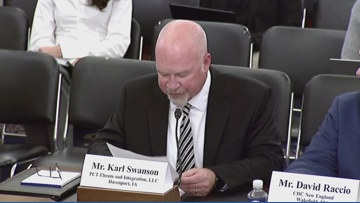Report on Klein ISD Enrollment Growth and Alignment with Sustainable Development Goals
Executive Summary
The Klein Independent School District (Klein ISD) has reported a significant increase in student enrollment for the upcoming 2025 academic year. The influx of over 1,500 new students represents a 15% increase compared to the previous year, elevating the district’s total student population to over 53,000. This growth is attributed to several key factors that align with the United Nations Sustainable Development Goals (SDGs), particularly in the areas of quality education, reduced inequalities, and sustainable communities.
Analysis of Growth Drivers and SDG Contributions
SDG 4: Quality Education
Klein ISD’s growth is substantially driven by its commitment to providing inclusive and equitable quality education. This aligns directly with SDG 4, which aims to ensure lifelong learning opportunities for all.
- High Academic Standards: The district is recognized for its high academic benchmarks, including early access to Advanced Placement (AP) and International Baccalaureate (IB) courses. New student Noor Arif cited this as a primary reason for her enrollment, stating she was “looking forward to being able to take a lot more advanced classes earlier.”
- Holistic Development: A wide array of athletics programs and student clubs are offered, contributing to the well-rounded development of students beyond core academics.
SDG 10: Reduced Inequalities & SDG 11: Sustainable Cities and Communities
The district’s appeal is strongly linked to its diverse and inclusive environment, a cornerstone of SDG 10 (Reduced Inequalities) and a key component of SDG 11 (Sustainable Cities and Communities).
- Diversity as a Key Attractor: Families are actively seeking the diverse demographic composition of the district. Relocating parent Fouzia Khan emphasized this factor, noting, “We actually love the diversity here…to make sure there’s people of all kinds…reflecting real life, a real world.” This highlights the district’s role in fostering an inclusive society.
- Quality of Life: The “appealing quality of life in the Klein area” was cited as a significant draw, indicating that the school district is an integral part of a thriving and sustainable community.
SDG 16: Peace, Justice and Strong Institutions
Klein ISD has demonstrated effective and inclusive institutional practices, which is a core target of SDG 16. The district’s proactive measures have made its educational services more accessible and efficient.
- Accessible Enrollment Processes: A two-day “mega-enrollment event” was successfully hosted to manage the influx of new students, streamlining the process for families.
- Institutional Responsiveness: Officials report that these in-person events, supplemented by ongoing online enrollment, have made the process “faster and more accessible for families,” showcasing an effective and accountable institution.
Conclusion
Forward Outlook
The substantial enrollment growth in Klein ISD is a testament to its successful alignment with key principles of sustainable development. By providing high-quality education, fostering an inclusive and diverse community, and operating as a strong and accessible institution, the district has established itself as a desirable destination for families. This growth solidifies its standing as the 14th largest school district in Texas and underscores its role as a leader in building a sustainable future through education.
SDGs Addressed in the Article
-
SDG 4: Quality Education
The article’s central theme is the significant increase in student enrollment in Klein ISD, driven by the district’s reputation for high-quality education. It explicitly mentions “high academic standards,” “early access to AP/IB courses,” and diverse extracurricular offerings like “strong athletics and club offerings.” These elements directly correspond to the goal of ensuring inclusive and equitable quality education.
-
SDG 10: Reduced Inequalities
The article highlights that diversity is a key factor attracting new families. A parent is quoted saying, “we actually love the diversity here… to make sure there’s people of all kinds, uh, you know, reflecting real life, a real world.” This directly relates to promoting social inclusion and valuing diversity, which is a core principle of reducing inequalities.
-
SDG 11: Sustainable Cities and Communities
The influx of over 1,500 new students and the district’s growth to become the “14th largest school district in Texas” signify rapid urbanization in the Klein area. The article mentions that an “appealing quality of life” is a draw for new families, and the district’s organized response with a “mega-enrollment event” demonstrates a form of planning and management to accommodate this growth, which is relevant to making communities inclusive and sustainable.
Specific SDG Targets Identified
-
Target 4.1: By 2030, ensure that all girls and boys complete free, equitable and quality primary and secondary education.
The article supports this target by highlighting Klein ISD’s commitment to quality secondary education. The mention of “high academic standards” and a student’s excitement about being “able to take a lot more advanced classes earlier,” specifically AP and IB courses, points directly to the provision of quality learning opportunities at the secondary level.
-
Target 4.7: By 2030, ensure that all learners acquire the knowledge and skills needed to promote sustainable development, including…appreciation of cultural diversity.
This target is addressed through the emphasis on diversity. The parent’s statement about choosing the district because it has “people of all kinds” and reflects the “real world” shows that the community and its educational system are perceived as environments that foster an appreciation for cultural diversity, a key component of this target.
-
Target 10.2: By 2030, empower and promote the social…inclusion of all, irrespective of…race, ethnicity, origin…or other status.
The article implies progress toward this target by showcasing the district’s diversity as a major attraction. When a family actively seeks out and praises a district for its diversity, it indicates that the district is successfully fostering an inclusive environment that is welcoming to people of various backgrounds.
-
Target 11.3: By 2030, enhance inclusive and sustainable urbanization and capacity for…sustainable human settlement planning and management.
The “major spike in enrollment” and the “15% increase over last year’s numbers” are clear signs of urbanization impacting the school district. The district’s proactive measure of hosting a “two-day mega-enrollment event” to “accommodate the influx of new students” is a direct example of management and planning to cope with this rapid growth in a sustainable and organized manner.
Indicators for Measuring Progress
-
Indicators for Target 4.1 (Quality Education):
- Mentioned: The number of new students enrolling (“More than 1,500 new students enrolled”) and the percentage increase in enrollment (“a 15% increase over last year’s numbers”) serve as proxy indicators for the perceived quality and attractiveness of the education provided.
- Implied: The availability and accessibility of advanced academic programs. The article implies this can be measured by the “early access to AP/IB courses,” which is a specific feature of the district’s quality education.
-
Indicators for Target 4.7 & 10.2 (Diversity and Inclusion):
- Implied: Perception of inclusivity and diversity within the school system. This is qualitatively measured by the parent’s testimony: “we actually love the diversity here…That’s one of the things we looked at.” This feedback serves as an indicator of a successfully inclusive environment.
-
Indicators for Target 11.3 (Sustainable Urbanization):
- Mentioned: The rate of population growth within the district, which can be measured by the “15% increase” in student enrollment.
- Implied: The implementation of management strategies to handle population growth. The “two-day mega-enrollment event” is a specific, measurable action taken by the district to manage the influx of new residents.
SDGs, Targets, and Indicators Analysis
| SDGs | Targets | Indicators Identified in the Article |
|---|---|---|
| SDG 4: Quality Education | Target 4.1: Ensure equitable and quality primary and secondary education. |
|
| SDG 10: Reduced Inequalities | Target 10.2: Promote social inclusion of all. |
|
| SDG 11: Sustainable Cities and Communities | Target 11.3: Enhance inclusive and sustainable urbanization and planning. |
|
Source: khou.com







